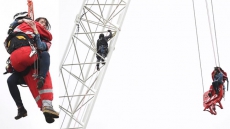OTTAWA — Defence Minister Harjit Sajjan was again defending himself in the Commons on Tuesday, repeating his apology for claiming to have been the architect of Operation Medusa, a major Canadian-led military offensive in Afghanistan in September 2006.
Here are five things to know about his role and the battle itself.
1) Sajjan, who joined the reserves in 1989, deployed to Afghanistan in 2006. In a book about the war, Canadian military historian Sean Maloney says Sajjan was brought to Kandahar by Brig.-Gen David Fraser, who wanted to draw upon Sajjan's experience in the Vancouver police gangs unit. Sajjan was to be a liaison officer with the Afghan security forces.

2) Maloney wrote that Sajjan was instrumental in gathering badly needed intelligence at a critical time that saw Canadian Forces take over control of Kandahar. Sajjan worked with his Afghan security contacts and the Afghan government to develop a better understanding of the forces at play and the connections between them. Of key concern was the fact the Taliban had begun to surge in strength in the key region of Kandahar know as the Panjwai.

3) Sajjan's efforts brought him recognition. His work was acknowledged in what's known as a "mention in dispatches" in the military. That citation said: "In September 2006, his understanding of counter-insurgency tactics assisted in the effective planning and execution of an operation to secure key terrain in the Panjwayi/Zhari District.”

4) Operation Medusa ran from Sept. 2 to 17, 2006 and was the culmination of a fight to retake Panjwai that had begun in August. Medusa was the first large-scale combat assault in NATO's history and marked the first major Canadian battle since the Korean War. Warrant Officer Richard Nolan, Warrant Officer Frank Mellish, Sgt. Shane Stachnik and Pte. William Cushley were killed on Sept. 3, while Pte. Mark Anthony Graham died in a friendly fire incident the next day. Sajjan later told an interviewer he returned home shortly after Medusa.

5) Medusa had mixed results. The operation proved that the Taliban could be beaten with a traditional military approach. But the day after the operation ended, four Canadians were killed by a suicide bomber in Panjwai. After Medusa, the Taliban resumed the guerilla tactics which confound Western militaries to this day. While Canada withdrew from a combat role in Afghanistan in 2011, Sajjan's expertise continued to be in demand; he would return two more times.




